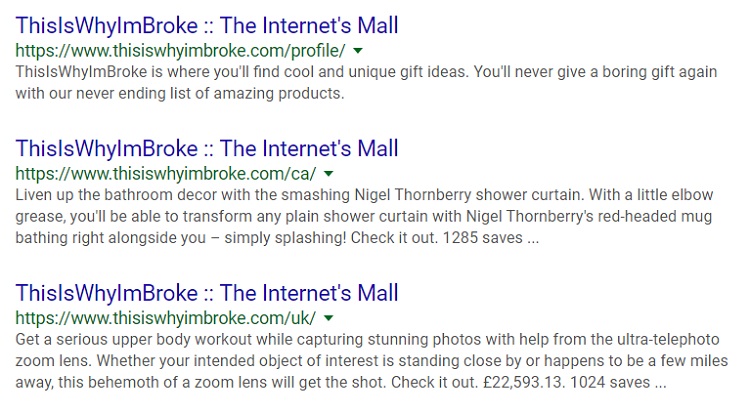SEO-friendly meta descriptions and tags were all the rage a decade ago. They were quite effective in boosting search engine rankings which lead many site owners to “stuff” their pages with keywords. Google (and other search engines) let this slide for a while but eventually gave these sites a slap.
Today, meta descriptions don’t play nearly as big of a role with search ranking factors. In fact, Google doesn’t use them at all… but, they’re something you should do, regardless. Mainly because they are a good practice for usability and provide the benefit of encouraging clicks to your page.
Your Meta versus SEO-friendly Meta Descriptions They Warned You About
It’s quite surprising seeing so many fall flat with their meta descriptions after writing elaborate, long-form blog posts. They’ve put all this time into the content and crafting headlines yet let search engines pick up autogenerated meta descriptions or slap something together for the sake of routine.

You can see the result of a lazy meta description when you’re finding search results like the example above. The search engine typically pulls the opening paragraph. Sometimes this is okay if the work is refined and crafted with copywriting in mind… but usually not so much.

Then you have what we’d call an “okay” meta description.
This is a description that tries to explain what the article is about while including a couple keywords to improve search rankings. It’s nothing fancy but it’ll get the job done.
But…

You could do your content one better by including hooks to build interest and trust.
This follows the same approach as writing good headlines in which you present a problem, hook the reader with an interesting fact or touch on a pain point, then suggest a solution (found in the post).
Meta descriptions using this structure generally improve clickthrough rate.
Clickthrough is one of the BIG SEO factors Google (and others) are using to help determine your page placement in search results. Think of it as thumbs up from search engine users. If you’re getting more clicks (and site time) for your page over the competition, then Google wants that post higher up.
Crafting SEO-Friendly Meta Descriptions for Each Page: A How-to
The meta description HTML is applied inside the <head>’s <meta> tag of your pages:
<head>
<meta name=“description” content=“This is where you’d place the meta description.”>
</head>
Else, platforms like WordPress and other CMSs will generally have these available during editing. Yoast is a popular SEO plugin for crafting SEO-friendly metadata (it’s free and usually appears on everyone’s list of essential WP plugins – for good reason).
Making the meta description SEO-friendly is very easy:
Keyword(s)
Include the main keyword somewhere in the description (without stop words).

Try front-loading it by placing it up closer to the beginning if you can else anywhere is fine if you’re creative enough. Attach the keyword to copy while explaining the benefit of the post, too, this way you’re providing them a good reason to click.
Keep the keyword(s) and description as relevant as you can without trailing too far off.
Length
Google is exploring longer descriptions but it’s best to keep them under 155 characters.

The 155 mark gives you just enough to pitch the idea without it becoming wordy. Don’t go too low, either, else you’ll cut-off your ability to create excitement and add the…
Call-to-action
Remember: The description doesn’t add SEO “weight” – it’s there to encourage search engine users to click through to your page. Adding a call-to-action in the description will increase clickthrough rate.

Use action in your copy.
Instead of “Consider checking out this…” use “Download this…” which removes hesitation. It gets readers pump for what they’re about to discover. It’s the difference between “go” and “get ready”, basically, so pick a tone and stick to it – build that hype!
More Meta Descriptions Examples
Since we’re looking at getting clicks – we wanted to share some of the descriptions that have enticed us to check out content. You’ll notice they follow the best practices but also put some time and effort into touching on providing solutions to a problem.
For example:
Instagram does a great job describing profiles (with stats)…

This description of an ‘SEO tips’ post makes it compelling…

We’d definitely click this if we were researching how to learn piano…

This guide seems like an excellent place to start…

The trust is strong with this one if we were in a shopping mood…

This tells us exactly what we’re getting (and more)…

You can see how they keep things short, with their main keyword, and use compelling copy to get our clicks. The headline catches our attention — the SEO-friendly meta description seals the deal.
Keep an eye out for descriptions that catch your eye and add them to a swipe file you could use whenever you’re feeling stumped or need inspiration.
What Not to Do with Meta Descriptions (and What to Do Instead)
Two quick things:
- Don’t stuff or use more than one keyword for your description
- Don’t duplicate the descriptions for other pages
It’s tempting to add a bunch of variations to the description when you’re editing. You think: the more the better, right? It’s the same as the page content in that you want search engines (and users) to understand the topic. Adding extra keywords that aren’t part of the content doesn’t do you good.

Also…
It’s worth your while to create unique meta descriptions for each page (even if they’re somewhat similar).

Yes, it seems daunting if you have thousands of pages in need of updating but it’s quite easy to do if you follow a format. Try this: record yourself describing the page as if you’re telling it to a friend, then go back, transcribe the description, and add in the appropriate keywords.
You could also copy good meta description examples as a starting point.
Look:
If you’re groaning about doing descriptions for each page – consider outsourcing to a virtual assistant and having them write unique descriptions for each. Easy!
Improve Meta Description SEO with Rich Snippets
One way to up the value of your descriptions is by using rich snippets.
Rich snippets are structured code that makes it easier for machines to pick up and understand. You can add your own by using best practices and generators via Schema or, again, use the Yoast plugin (or comparable offerings) to generate this good data.
Most pages you’re forming probably won’t use rich snippets with the exceptions of:
- Products
- Reviews
- Location
- Recipes
There are a whole lot of others Google will likely implement over time. Pick and choose when you’re using them based on your niche and content, obviously.
Final Words about SEO-Friendly Meta Descriptions
I know, it seems goofy having to remind you to create unique, SEO-friendly meta descriptions…
…but people get lazy or outright forget about them.
They take less than a minute to piece together so there’s no excuse.
You’ll gain the benefit of higher clickthrough if you’re willing to put in the effort. Plus, you’re more than welcome to test and change them throughout the years to give yourself a bump in clicks.
It’s on you, though, so if you’re wondering why your great SEO content isn’t getting the traffic it deserves even though it’s ranking well… you know why.
What are your plans for the meta?




